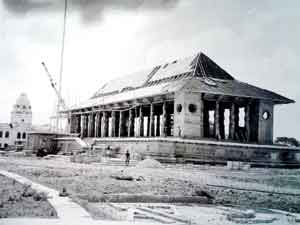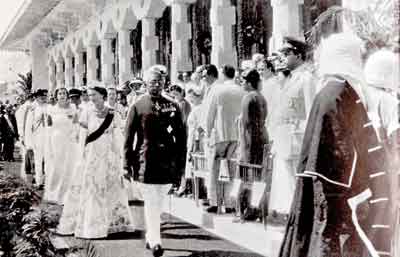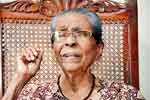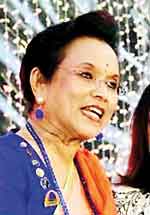Monument to freedom

Independence Hall under construction
“Four smart white clad relay runners from the ends of Lanka bearing scroll messages of hope and goodwill for the future entered the Independence Square sharp at 4.15 p.m. yesterday to complete the last act of Ceylon’s first anniversary celebrations of independence. It was a magnificent effort of co-ordination. The four scrolls were handed over to four girls representing the womanhood of the nation. The girls then turned towards the Premier and read the messages in Sinhalese, Arabic, English and Tamil….. The Prime Minister proceeded to lay the foundation stone of the Independence Column and immediately after a large number of pigeons were released. This was followed by Prime Minister’s address.” Thus records the Ceylon Observer of February 5, 1949.
The report further provides a detailed description of the ‘kap’ planting ceremony at the site chosen for the Independence Monument. “Ancient Sinhalese ceremonial was observed when at 10.35 a.m. yesterday the auspicious time, Sir John Kotelawala, Minister of Transport and Works, deputising for the Prime Minister performed the ‘kap’ planting ceremony. Earlier pooja ceremonies under E.A. Delgoda, the Basnayake Nilame were performed by the kapuralas. Milk was boiled at the Northern end of the octagon and coconuts were broken.”
Independence Memorial Hall, is indeed “one of the most outstanding sights of Colombo and one which, once seen, will not be forgotten,” true to the words of its principal architect T.N. Wynne Jones. More than a monument celebrating the country’s emancipation from colonial rule, this iconic edifice had been privy to occasions of national significance; both ceremonial and sombre, Parliament assemblies and civic receptions since its opening in late 1953. The Hall stands on the site of the temporary assembly hall, where the first Parliament was inaugurated on February 10, 1948 by the Duke of Gloucester.

Dr. Justin Samarasekera
Signing the decisive Kandyan Convention in the Magul Maduwa or the Audience Hall in Kandy in 1815 was the final blow to our national sovereignty. In a twist of destiny, the Magul Maduwa, replica now stands as a symbol of Independence. Interestingly, the design had however, been ‘unpremeditated’, according to Dr. Justin Samarasekera, a celebrated first generation local architect honed in the best of both the vernacular tradition and that of the West.
Dr. Samarasekera was among the Lankan architects who collaborated with Wynne Jones, on the Independence Memorial Hall. Citing her communication with Dr. Samarasekera in her work, ‘Architecture and Nationalism in Sri Lanka- the trouser under the cloth’, Dr. Anoma Pieris notes: ‘D.S. Senanayake, the first Prime Minister, who had once been a draughtsman at the PWD (Public Works Department), initially volunteered the design services of a friend in the Survey Department. He produced a design for a colonial saluting platform- a form wholly inappropriate for a nascent nation-state. H.J. Billimoria of the PWD, a pragmatic soul, suggested a hospital. Sir John Kotelawala, a minister- later to be Prime Minister called up Wynne-Jones and said, “I say, why don’t you build something like that audience hall in Kandy?” PWD architects were asked to sign a ‘no protest’ form to this recommendation.’

T.N. Wynne Jones
Fashioned on the Magul Maduwa, the Independence Hall takes the form of a long narrow open-sided structure with a two-pitched Kandyan roof. The Hall constitutes four corner towers and 48 pillars, based on the typical Kandyan design, with their elaborate pekadas. The ridge of the roof is modelled to the outline of the balustrades of the Temple of the Tooth Relic. Immediately above the column capitals and as viewed from inside the Hall, there will be a series of 28 vertical panels each of which is adorned with a pictorial design depicting an incident from our folklore. Below the hall is a large chamber of the same plan-dimension with 21 alcoves which was envisaged by the designers, to be a museum dedicated to the country’s history. The lower terrace with three tiers to the ground level includes a range of modelled ‘lions’ to all four sides.
The hall is mounted on a raised tiered terrace, enabling any person standing anywhere on the floor to be fully visible ‘from quite a short distance up to half a mile or so from the long sides’, as the principal architect of the project, Wynne Jones in his report ‘The Independence Commemoration Hall’ in CEYLON Today (the journal of the Ceylon Government Information Department) of September 1953 notes.
While drawing inspiration from the Magul Maduwa- the creative labour of the royal architect, Devendra Mulachari, the architects were conscious of its adaptability to a modern age. “It has been fully realized that this is the modern age, centuries later than the originals, and that the scheme is in a different location for a different purpose; and again, that the scale and materials and viewing angles are all entirely different,” documents Wynne Jones. The structure is completely free of wood work and even the ‘reepers’ are of precast concrete making the roof ‘completely weather-tight’. Thus “there is thus nothing to decay and nothing that can burn.” Pure white quartz obtained from a source discovered near Opanayaka gives the edifice its ‘scintillating whiteness.’ Remarking that, ‘it would be both incorrect and unwise to insist upon slavish copying of earlier examples; it is indeed most desirable that there should be a spontaneity of enthusiastic co-operation and contribution by the craftsmen,’ Wynne Jones further records that the best craftsmen from the country were selected for the purpose.

Queen Elizabeth II accompanied by Premier Sir John Kotelawala for the ceremonial opening of the third session of the second parliament in 1954
Speaking to the Sunday Times, eminent chartered architect and archaeologist Dr. Roland Silva notes that the choice of the design for the independence monument “couldn’t have been better”. Recalling the celebration he saw as a 15-year-old youngster, Dr. Silva chuckles: “the most vivid memory of mine is the blocking of the roads on the day the first Parliament was inaugurated! I travelled with my father from Giriulla for almost half-a-day to witness the celebrations at the temporary Assembly Hall.”
Dr. Silva endorses that all professionals and craftsmen involved in the making of Independence Hall “were well groomed” for a “neat job” done. The location chosen for the Hall, he points out had one time been an aerodrome. “During the World War the airstrip used to go from the Thurstan Road up to the present Independence Square where there was a hangar. The Independence Hall now stands where the runaway was.”
The Independence Hall had been declared a ‘Protected Monument’ during Dr. Silva’s tenure as Archaeological Commissioner and Director General of the Central Cultural Fund. “This was an exception to the 100-year requirement for a monument to be declared a protected one. It was done under very special approval.” He feels that today the character of the monument should be preserved at least within a radius of half a mile from it. “There should not be any developments done in this area which would hinder the environment the monument enables,” he adds.
Independence Hall which had been completed in late 1953 became the chosen site for the ceremonial opening of the third session of the second Parliament in 1954 graced by Queen Elizabeth 11. As ‘The Royal Visit’ published in the May-June, 1954 edition of CEYLON Today journal records, ‘Her Majesty wore her coronation robes for the occasion.’
Under the bold banner ‘Break with tradition not with the past’ the Ceylon Daily News of February 5th, 1957 records that ‘In Colombo the scene then shifted to the Independence Square not Galle Face Green as in the past, where 2500 school children from over 30 schools delighted the ‘largest ever’ Independence gathering with a march past, gymnastics and a physical drill display.’ Among the guests who graced the first ever Independence Day celebrations to be held at the Independence Hall, were the Governor General Sir Oliver Goonetilleke, Premier S.W.R.D. Bandaranaike and the Chinese Premier Chou En-lai and his entourage. The report says that the folk dances and the mass physical display by 700 school girls ‘moved the distinguished Chinese visitor to lean forward in his chair’.
If the Hall could talk, it would hold testimony to the ‘one sea of heads’ that the Independence Square was on February 4, 1957 to witness the spectacle on a new stage. The heavy rains which had fallen just a few minutes after the Independence Day public meeting began, could not dampen the spirits of the crowds. Instead, the Chinese Premier Chou En-lai who ‘brushed aside repeated offers of an umbrella’ and ‘chose to stand bareheaded in the rain’ sent ripples among them and as newspaper accounts of the day record, the Premier’s ‘example was infectious.’ As the umbrellas came down ‘the crowd stayed on to applaud almost every sentence of his speech.’
Truly a monument to ‘freedom’, this striking edifice marrying simplicity with architectural and artistic mastery rooted in a rich tradition, enables any visitor to be riveted in the tranquility it exudes. The Hall will continue to be a living embodiment of the prophetic words of Prime Minister D.S. Senanayake who reflected after laying its foundation stone: ‘Let us follow the truth, seek justice and work hard. There will then be enough for all in this fair island of ours. I trust that the monument which will arise here will inspire us all to more intense effort.’
(Pix courtesy Ceylon Observer, Ceylon Daily News, CEYLON Today Journal, the Architect 50 (1957-2007 Commemorative Volume of The
Sri Lanka Institute of Architects))
| What they remember | |
 Sybil Wettasinghe Speaking to the Sunday Times, Chartered Architect Nela De Zoysa, daughter of Dr. Justin Samarasekera, says that she was a very young child when her illustrious father was engaged in the Independence Hall project. “Although my recollection of this particular endeavour are bleak since I was very young, I  Nela De Zoysa remember accompanying my father on various other projects he was assigned to, during his time as the Chief Architect of the Public Works Department and even later on when he pursued his private practice,” says Ms. De Zoysa who is the only Lankan architect to be bestowed an Honorary Fellowship of the American Institute of Architects after Geoffrey Bawa. Veteran artist Sybil Wettasinghe, then Sybil de Silva working at the Times of Ceylon had to daily submit ‘illustrations’ for the company’s newspapers. “I had to take my grandfather’s lunch to the site where the Independence Hall was being constructed,” says Sybil Wettasinghe, her grandfather being sculptor K.D. Samaris de Silva, one of the handpicked artists who lent his creative touch towards the ‘lions’ who guard the Independence Monument. “I still remember how he was immersed in his work, surrounded by cement and mortar,” Sybil says.
|


